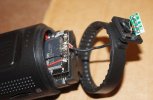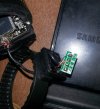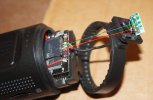Sunny
Well-Known Member
- Joined
- May 31, 2014
- Messages
- 5,095
- Reaction score
- 1,739
- Location
- Colorado
- Country
- United States
- Dash Cam
- More than I can review. ;)
Okay, after my unsuccessful attempt to fix the wires that came de-soldered, I opened up the mount to replace the wires with something stronger.
Now I see there is enough wire there curled up.
It'd have made it much easier to solder had I pulled the wire little bit.
Anyways, I am confused on the labeling.


On the board, it has
RX
GND
5V
TX
How do I read it?
Is TX the next solder joint or the one on the other side?
And reading the DIY thread, it's mentioned that,
Green is next to TX label on the board followed by copper followed by red and finally blue/red.
On the mount, the correct color and code are together.
TX is green.
GND is copper.
VCC is red. --> 5v
EN is blue/red. --> I suppose this is RX.
The suggested order in the DIY thread doesn't make sense whether I start green at TX on the board or on the other side.
If I start green next to TX, the next one should be red 5V, not copper as suggested.
If I start green on the other side, next to the other side is 5v that's correct as well as the GND after that but then the suggested order doesn't match because DIY thread suggests green should be next to TX marking and blue/red is the actual TX but the mount has green as TX. WTH???
Is the green colored wire soldered at TX by mistake in the mount instead of RX blue/red?
Thanks for clarifying before I start again on soldering these with new wires.

So should the TX/green wire be soldered on the other side of TX label or right next to TX label?

Now I see there is enough wire there curled up.
It'd have made it much easier to solder had I pulled the wire little bit.
Anyways, I am confused on the labeling.


On the board, it has
RX
GND
5V
TX
How do I read it?
Is TX the next solder joint or the one on the other side?
And reading the DIY thread, it's mentioned that,
Green is next to TX label on the board followed by copper followed by red and finally blue/red.
On the mount, the correct color and code are together.
TX is green.
GND is copper.
VCC is red. --> 5v
EN is blue/red. --> I suppose this is RX.
The suggested order in the DIY thread doesn't make sense whether I start green at TX on the board or on the other side.
If I start green next to TX, the next one should be red 5V, not copper as suggested.
If I start green on the other side, next to the other side is 5v that's correct as well as the GND after that but then the suggested order doesn't match because DIY thread suggests green should be next to TX marking and blue/red is the actual TX but the mount has green as TX. WTH???
Is the green colored wire soldered at TX by mistake in the mount instead of RX blue/red?
Thanks for clarifying before I start again on soldering these with new wires.

So should the TX/green wire be soldered on the other side of TX label or right next to TX label?


